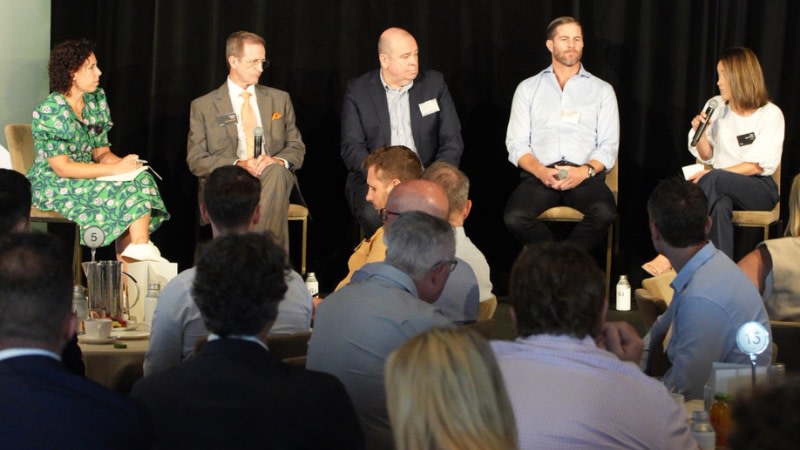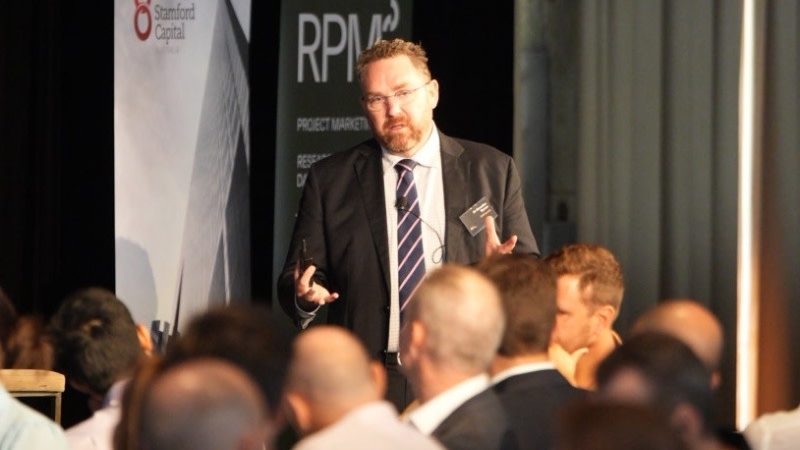Resources
Newsletter
Stay up to date and with the latest news, projects, deals and features.
Subscribe
The silence was deafening from the roomful of Queensland development industry stakeholders but the sobering message was loud and clear.
There are already a lot of uncontrollable balls in the air but the juggling act for the teetering sector is about to become a lot tougher over the next 12 to 18 months.
Inflated construction costs that are likely “not coming back anytime soon” and “nowhere near enough” skilled labour to deliver the state’s huge pipeline of projects are the two biggest challenges going forward.
And according to KPMG chief economist Dr Brendan Rynne, the overarching impact of nine consecutive interest rate hikes is starting to bite hard—with at least two or more increases to come.
“It’s pretty clear [Reserve Bank governor Philip] Lowe knows that he’s not going to get another term and he’s going to go out with all guns firing,” he told the 350-strong packed room, creating a brief moment of laughter at The Urban Developer Queensland Property and Economic Outlook event in Brisbane.
Rynne said last week's 0.25 per cent cash rate rise was “fair warning” the RBA is going to “keep pumping up rates until we stop spending” in a bid to tame record inflation.
As a result, he said, the expectation is “the Australian economy is going to slow and slow pretty rapidly over this year”.
And although he warned the industry it was time to “get your own finances in order, sort out your own cost structures, minimise your own expenses and basically hunker down” he added “it's a cycle, the tough times ahead of us are not going to last forever”.
Tempering his grim analysis and forecasts, Rynne said the challenging times also presented some opportunities for the industry.
“If you’ve got a good balance sheet … use this as an opportunity for land supply and stocking for the next cycle that comes through.

“And for those that are really ballsy, you know, fortune favours the brave. Because, as I said, there's going to need to be supply but you need to be building in a cost effective way. And it might be that the product that you built last year isn't going to be the product that you can afford to sell this year or next.”
Brisbane-based Mosaic Property Group managing director Brook Monahan said the industry’s biggest issue is the increasing inability to deliver projects.
“There’s real concerns over not just solvency, but capability, there just isn’t the number of people on the ground at the moment,” he said. “There’s just nowhere near enough labour.
“More people have come to us since the end of November until now—with really good projects that they just can't deliver—than we would have seen in the last five or six years.
“[In particular] the structure to get built form, mid to high-rise buildings, out of the ground is a problem because you've got Queens Wharf, you've now got Dexus that's come online [with Waterfront Brisbane] and you've got all of this state government work, let alone what's going on with the Olympics, that is competing for the same trade.”
Monahan also said the speed of escalation in construction prices, on both the material and labour side, during the past two years had been “quite extreme”.
“I do think the challenges of the construction sector are unlikely to improve in the foreseeable future,” he said.
“So it’ll just be a matter of those projects that are well funded … to establish relationships with those builders that have got capability. But there’s going to have to be some realistic discussions around where those prices land because I can’t see construction prices coming back anytime soon.”
Fund manager Sentinel Property Group chief executive Warren Ebert said its gaze was firmly fixed on northern Australia where it already has a $1 billion-plus portfolio of assets.
But he said while “the wealth of Australia is being created in northern Australia” its growth also was facing challenges due to the problems in the contruction industry.
“As things go through cycles, and things slow down in the southern states, you'll see subbies and tradies head up north ... but at the moment it's so busy in all the southern states, while the labour shortage is bad here, it's worse up there, ” Ebert said.
Development project management and advisory firm Bluebird partner Riye Arai-Coupe said despite the challenging conditions across the industry in Queensland, to date none of the company’s clients have been shelving projects.

“We’ve been quite cautious,” she said. “And when we started seeing some of these pressures from the market, we made sure that our projects and our feasibilities were fairly robust and had some adequate contingencies in place.
“But that’s not to say that projects that we’ve worked on haven’t had their fair share of challenges.”
Arai-Coupe also said towards the end of last year there had been “a definite softening of the market” that was reflected in terms of both sales inquiries and transactions.
From a financing perspective, she said the banks were still eager to fund development projects and “the biggest question is no longer so much about sales per se, it's about the builder and the quality of the builder—that's all they want to talk about”.
On the construction side, Bluebird is still forecasting price escalations of at least 0.5 per cent each month at the moment. Others at the coalface are saying it will be around 1 per cent.
“So, in the foreseeable future until we've got supply and more competitors in the building space to help resolve this, we're not seeing that's going to ease off in the short-term,” Arai-Coupe said.
Build-to-rent owner and operator Arklife managing director Scott Ponton said there were definite parallels in some instances between what the industry was experiencing now and what it went through just prior to the GFC.
“Last year to me felt like late 2006-early 2007, where everything was a bit sort of frothy earlier in the year, things were going well and then you start to see increase in pricing and your cost of goods going up quite significantly.”
But he said the GFC was “a hard landing and everything re-priced very quickly”.
“Whereas this time, and from what Brendan describes, it feels like we’re going to go through that re-pricing over a longer period of time … what you’d describe as a soft landing.”
And no doubt a lot of people who were in the room, quietly hanging on every word from Ponton and the other speakers, are hoping he is right.
The Urban Developer presents its annual flagship in-person Australian Property and Economic Outlook series.